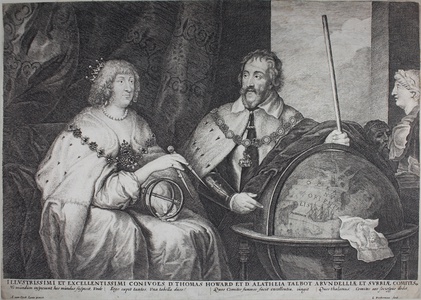| Method | Copper engraving |
| Artist | Lucas Vorsterman I after Anthony van Dyck |
| Published | [Antwerp, c.1640] (18th century impression) |
| Dimensions | Image 285 x 428 mm, Sheet 307 x 435 mm |
| Notes |
Portrait of Thomas Howard, 2nd Earl of Arundel, alongside his wife, Alathea, Countess of Arundel and Surrey. The Earl is seated to the right behind a globe, holding a baton in his left hand, and wearing the Order of the Garter around his neck. With his right hand, he points towards Madagascar on the globe. To the left is the Countess, also seated, wearing an ermine robe, tiara, and jewels. In her right hand, she holds a pair of callipers, and in her left hand, resting in her lap, is another form of measuring instrument. Thomas Howard, 2nd Earl of Arundel (1585 - 1646), although a British politician and a prominent courtier during the reigns of King James I and King Charles I, is primarily known as a Grand Tourist, a collector, and a great patron of the arts. On his death, his collection consisted of some 700 paintings, alongside vast collections of sculpture, books, prints, drawings, and antique jewellery. Whilst many of the drawings from his collection are now held at the Royal Library at Windsor Castle, or at Chatsworth, his collection of antique sculptures, those of which now take the name the Arundel Marbles, were left to the University of Oxford. Today, the marbles are held at the Ashmolean Museum, Oxford. Lucas Vorsterman (1595 – 1675) was a Baroque engraver. He worked with the artists Peter Paul Rubens and Anthony van Dyck, as well as for patrons such as Thomas Howard, 2nd Earl of Arundel and Charles I of England. Around 1617 Vorsterman joined Rubens's workshop and became Rubens's primary engraver for several years. Rubens was a demanding employer of engravers, with a very specific idea of the style he wanted: "As he dismissed engraver after engraver, he drove the best one, Lucas Vorsterman, into a nervous breakdown". In 1624, Vosterman moved to England. He was back in Antwerp around 1630, where he worked closely with Van Dyck, including some of the engraved artists' portraits in the Iconography project. Anthony van Dyck (1599-1641) was a Flemish painter. A pupil of Rubens, Van Dyck worked in Italy from 1621-26, and then from 1632 onwards he predominantly painted in England, where he was knighted by Charles I. O'Donoghue 1908-25 29, Hollstein 133.II (Vorsterman), New Hollstein (Dutch & Flemish) 370 (Van Dyck) Condition: Trimmed within plate mark, originally tipped to album page, repaired tear to bottom margin, time toning to sheet, some creasing to sheet. Paper watermarked "J. Whatman". |
| Framing | unmounted |
| Price | £250.00 |
| Stock ID | 48405 |

